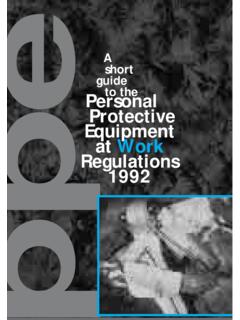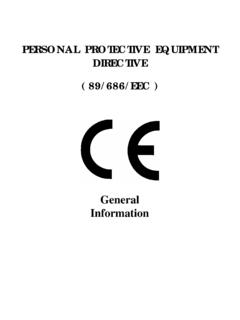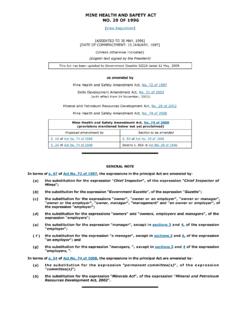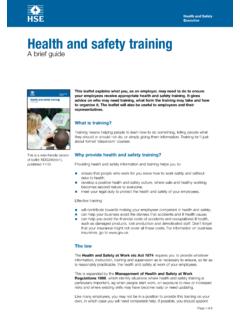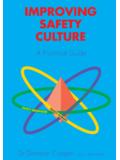Transcription of indg343 directors responsibilities for health and …
1 2 IntroductionThis guidance is for board members of all types of organisations in both the private and public sectors. It will help them ensure that the health and safety risks arising fromtheir organisation s activities are properly managed. The focus is mainly on the health and safety responsibilities ofcompany directors . In the context of effective corporate governance, managingcorporate risk is a key issue for all directors and senior managers. Such risks take many forms, as the TurnbullReport *makes clear (see Further reading ). One key risk area is the health and safety of an organisation s workers, andof others (including members of the public) who may be affected by its activities.
2 Effective management of health and safety risks will help: lmaximise the well-being and productivity of all people working for an organisation;lstop people getting injured, ill or killed through work activities;limprove the organisation s reputation in the eyes of customers, competitors, suppliers, other stakeholders and the wider community; lavoid damaging effects on turnover and profitability;lencourage better relationships with contractors and moreeffective contracted activities; and3 directors responsibilities for health and safety *This Code states that the directors should, at least annually, review systems of control including risk management, financial, operational and compliance controls that are the key to the fulfilment of the company s business the likelihood of prosecution and consequent p e n a l t i e s.
3 This health and safety Commission (HSC) guidance explainshow directors *can ensure that their organisation has an active,effective approach to managing health and safety risks. Who should read this guidance?This guidance is for the people who provide strategic leader-ship, direction and oversight and set the policy on health andsafety. For incorporated bodies this will be the board of public and voluntary sector organisations it will usually be thesenior management board that provides strategic oversight the guidance doesThe guidance sets out the roles and responsibilities of theboard and its members in respect of health and safety risksarising from the organisation s activities.
4 It recommends thatevery board should appoint one of their number to be a healthand safety director . It is also important that directors , in carryingout their responsibilities , set out their expectations of senior managers with health and safety responsibilities and thearrangements for keeping the board informed and advised of allrelevant matters concerning informationThe guidance stands alone, but HSC and the health andSafety Executive (HSE) publish a range of guidance thatboards and their members may find helpful. A Further reading section is provided at the back of the leaflet.
5 HSE Books( ) provides access to HSC/E *The term director is used to indicate a member of a board; the guidance applies much more widely than to companies that are obliged by law to have point 1 The board needs to accept formally and publicly its collective role in providing health and safety leadershipin its leadership is vital in delivering effective health and safetyrisk control. Everyone should know - and believe - that you arecommitted to continuous improvement in health and safety performance. You need to explain your expectations, and howyour organisation and procedures will deliver them.
6 Your statement of health and safety policy and arrangementsshould be a living document, devised in consultation with yourworkers, reviewed and revised as situations change, and bebrought to the attention of all your workers. (See the Summaryof legal responsibilities .)Action point 2 Each member of the board needs to accept their individual role in providing health and safety leadershipfor their a board member you need to ensure that your actions anddecisions at work always reinforce the messages in the board shealth and safety policy statement. Any mismatch between your individual attitudes, behaviour or decisions and your organisation s health and safety policy will undermine your workers belief in both your intentions and those of your boardand will undermine good health and safety must recognise your personal responsibilities and liabilities under health and safety law (see the Summary of legalresponsibilities ).
7 5 directors responsibilities for health and safety Action point 3 The board needs to ensure that all board decisions reflectits health and safety intentions, as articulated in thehealth and safety policy of your business decisions will have health and safetyimplications. It is particularly important that the health and safetyramifications of investment in new plant, premises, processes orproducts are taken into account as the decisions are made. Forexample, such changes could introduce:lNew materials - are they toxic, do they pose new risks andhow will any new risks be controlled?
8 LNew work practices - what are the new risks and are managers and supervisors competent to induct workers in the new practices?lNew people - do they need health and safety training and are they sufficiently competent to do the job safely? Too often organisations find that they have to remedy health andsafety problems that could have been dealt with more easily andcheaply when the initial investment decisions were made. Doing business with organisations that do not themselves delivereffective health and safety risk management may seriously damage both your corporate reputation and the effective andtimely delivery of contracted goods or services.
9 You need to ensure that your purchasing decisions, or decisionsto engage contractors to work for you, reinforce rather than damage your health and safety intentions. It is important thatdirectors recognise their continuing responsibility for health and6safety when work is contracted out. Similarly, you need to besure that your customers are alerted to any risks and necessary precautions associated with the products and/or services is important for boards to remember that, although health andsafety functions can (and should) be delegated, legal responsibility for health and safety rests with the point 4 The board needs to recognise its role in engaging theactive participation of workers in improving health health and safety risk management requires the activeparticipation of your workers.
10 There are legal requirements aboutconsulting your workers, via their trades union representatives ifappropriate (see the Summary of legal responsibilities ). Manysuccessful organisations go further and actively promote andsupport worker involvement and consultation. You shouldencourage workers at all levels to become actively involved in allaspects of your health and safety management system. Worker involvement supports a positive health and safety culture where health and safety is everyone s business. The bestform of participation is a partnership for prevention, where workers and their representatives are involved in identifying andtackling potential or actual problems, rather than being consulted only after decisions have already been taken.


